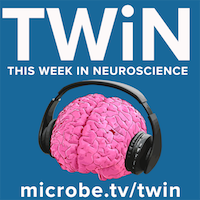TWiN explores a study of hallucination-like perception in mice which supports the idea that hallucinations arise as faulty perceptual inferences due to elevated dopamine in the striatum.
While perceptual constancy requires the brain to maintain a stable representation of sensory input, TWiN explores a study showing that odor-evoked responses in the olfactory cortex drift over periods of days to weeks.
On this episode, Vivianne gives a primer on glial cells, with the goal of thinking about the central nervous system holistically and appreciating the different cell types that contribute to its function.
Mauro Costa-Mattioli joins TWiN to discuss how his laboratory dissects the contribution of host genetics and the microbiome in complex neurodevelopment disorders such as autism spectrum disorders.
Michael Nitabach joins TWiN to discuss the finding that the nematode C. elegans, which do not have eyes, can discriminate between colors to guide foraging decisions and move them away from harmful bacteria that produce a blue-pigment toxin.
Stefano joins TWiN to discuss his work on understanding genomic decoding of neuronal depolarization by stimulus-specific transcriptional regulators.
Helen joins TWiN to discuss her work on understanding how the maternal microbiome modulates fetal neurodevelopment in mice.
Ori, Jason, and Vincent discuss the use of antibodies to neutralize amyloid-β seeds before their deposition becomes detectable in transgenic mice, and the finding that the preclinical phase of Alzheimer‘s disease may be a late manifestation of earlier pathogenic seed formation.
Ori, Jason, Erin, and Vincent dissect a study that utilizes single-cell RNA sequencing to reveal the genes that underlie remote memory storage in the medial prefrontal cortex of the mouse.
Ori, Jason, and Vincent reveal identification of an orphan receptor that modifies short-term memory in mice, and a mouse model of COVID-19 that includes anosmia or loss of smell.





